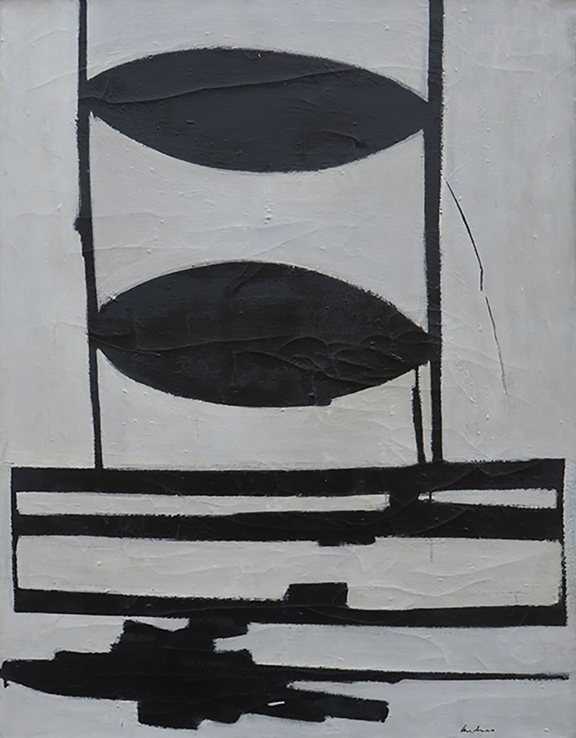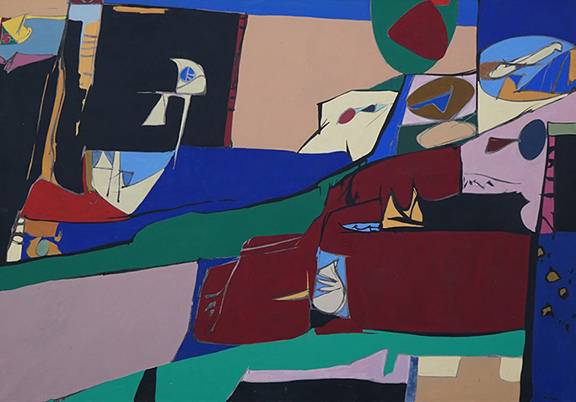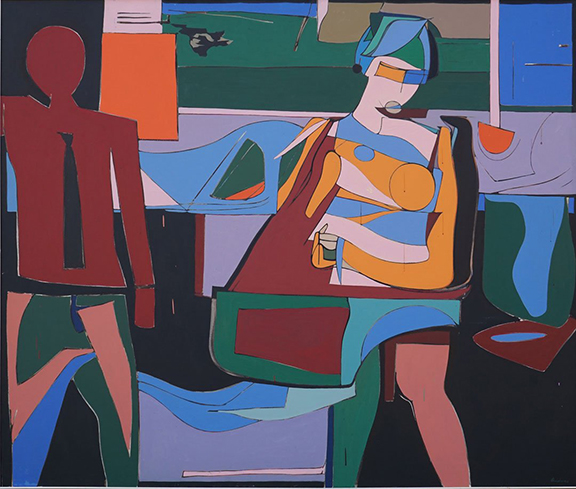BEACHWOOD, Ohio — A posthumous and partial retrospective exhibition at WOLFS gallery on the impressive abstract paintings of the late Cleveland-area artist Richard Andres from 1950 to 1975 is a bittersweet revelation.
The revelation is that Andres, (1927-2013) who has been overlooked for decades, became a very strong artist in Northeast Ohio after World War II. Combining idiosyncratic abstract shapes, bold colors, and wide-ranging moods, his paintings are very much worth appreciating today.
 The bittersweet part is that despite his abundant gifts, Andres largely confined his energies to Greater Cleveland and never fully engaged with the art of his time, which evolved rapidly beyond the mid-century modernism he embraced in the 1950s. In subsequent decades, he became an artistic holdover who stayed true to a vision that became increasingly anachronistic as the art world moved on.
The bittersweet part is that despite his abundant gifts, Andres largely confined his energies to Greater Cleveland and never fully engaged with the art of his time, which evolved rapidly beyond the mid-century modernism he embraced in the 1950s. In subsequent decades, he became an artistic holdover who stayed true to a vision that became increasingly anachronistic as the art world moved on.
Andres didn’t respond to Pop Art, Op Art, Minimalism, Conceptualism, or myriad aspects of Postmodernism that unfolded after 1960. He just kept chugging along as if the 1950s never ended.
The WOLFS show, on view through Aug. 20, thus has a hermetic quality that embodies the cultural time-lag affecting some Cleveland artists of the past half-century. It makes you wonder how Andres’ story might have been different if he had made different choices.
But it’s hard to understand Andres completely now because the WOLFS show stops in 1975. Art dealer Michael Wolf said he’ll hold an exhibit on Andres’ works from the latter 1970s and ‘80s in a year or two.
That’s disappointing because, to judge from photographs of the more recent works, Andres loosened up considerably in the latter part of his career, achieving a greater lushness and freedom that represented an advance from the flat, lean, papery look of his earlier works.
[Wolfs reveals the hidden art of painter Richard Andres]
A post-1975 painting by Richard Andres, not on view in the summer 2022 show of his work at Wolfs gallery, illustrates fresh directions in his work after the period explored in the show.Courtesy Wolfs gallery
His later paintings adopted a hotter and more vibrant palette, and his brushwork became freer and more confident. Some paintings seem to glow like stained glass, at least to judge by photos of them.
Seeing the full arc of Andres’ career now would have been better than just seeing the first part of a two-part series. Even so, as the first substantive Andres show in roughly 30 years, the WOLFS exhibit is an important artistic event. It follows the death of his wife, the portrait painter Avis Andres, in 2020 at age 92 and an agreement with the Andres estate that WOLFS will represent their work, Wolf said.
Unlikely roots
Andres came from an unlikely background. He was a son of two factory workers in Buffalo who supplemented their income by running a bar on the side. His father left school after third grade and his mother never attended high school, according to an essay in the catalog of the WOLFS show written by Case Western Reserve University art historian Henry Adams.
Andres developed a passion for drawing as a child that grew stronger after he visited what is now the Albright-Knox Art Gallery — an excellent museum famous for its focus on modern and contemporary art.
After graduating with honors from Buffalo Technical High School in 1945, Andres earned a bachelor of fine arts degree at the Cleveland Institute of Art in 1950, where he met his future wife, the former Avis Hazel Johnson. After a stint in the Army, Andres completed a bachelor’s degree in education at Kent State University in 1954, and a master of fine arts at KSU in 1961.
While teaching in Cleveland high schools from 1955 to 1983, Andres developed a local reputation for making abstract paintings that showed a keen awareness of the avant-gardes in Europe and America from the 1910s to the 1950s.
Influenced by artists as diverse as Pablo Picasso, Henri Matisse, Joan Miro, Max Beckmann, Robert Motherwell, Arshile Gorky, Jackson Pollock, and Willem de Kooning, Andres steered a middle course between the muscular gestures of Abstract Expressionism, the jump-cut spatial qualities of Cubist collage, and the soft, curvy shapes of Biomorphic Surrealism.
Paintings in the WOLFS show include quotations from the works of the artists Andres admired, including lumbering black shapes that echo Motherwell’s “Elegy to the Spanish Republic’' series, or the urgent, jagged, thrusting brushwork of de Kooning. Other paintings riff on the flat, curvy and spiky shapes of Miro’s abstracted surrealism.
Andres was hardly a secret at the time. By my count, he had no fewer than 147 paintings accepted in the Cleveland Museum of Art’s annual May Show between 1947 and 1984, an average of nearly four a year.
Yet today, Andres is virtually forgotten in part because he kept most of his paintings to himself, storing them in racks in the spacious, glassy, custom-designed house and studio in the leafy Summit County suburb of Hudson that he shared with his wife and their four children after 1967.
Supported by income from teaching, Andres apparently felt little pressure to sell his work, which would have dispersed it to museums, collectors, and the art market, creating regular, ongoing opportunities for visibility through shows and auctions.
Additionally, Andres “never seriously sought national recognition,’’ Adams wrote in his catalog essay. “He was content to quietly pursue his career as a painter in a secluded home of his own design, with big windows looking out on a forest setting, undistracted by the pursuit of fame.”
The upshot is that seeing a trove of Andres’ work today, as if it had suddenly emerged from an attic, produces mixed emotions.
It’s true that he was a wonderful painter who lived an enviable life of personal fulfillment in a beautiful setting. But the exhibition also raises questions about how to evaluate artists who stand apart from the major currents of their time, or who work outside mainstream centers of cultural production.
Andres was unlike the late Julian Stanczak, a longtime instructor at the Cleveland Institute of Art and an important progenitor of Op Art, who quickly earned international attention when he participated in a breakthrough exhibition at the Museum of Modern Art in New York in 1965, “The Responsive Eye.’’
Stanczak, like Andres, spent his entire career in Northeast Ohio. But Stanczak’s work evolved substantively during his long career here before he died in 2017 at age 88. He also lived long enough to see his art rediscovered and embraced widely by critics, scholars, and the art market, late in his life. For him, it was an overdue vindication.
“I am numb,” Stanczak said about the surge of interest in his work in the 2000s. “Once you get older, you look at it with a cat’s smile. It’s very pleasant, but where have you been all this time when I needed you?”
It’s easy to get the sense from the WOLFS show that Andres, unlike Stanczak, had no qualms about simply pursuing his muse in peace and tranquility.
His life and work bring to mind the title of artist Gerald Murphy’s memoir about living among the American expatriates of the Lost Generation in France after World War I: “Living Well is the Best Revenge.’’


